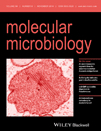- Submit a Protocol
- Receive Our Alerts
- Log in
- /
- Sign up
- My Bio Page
- Edit My Profile
- Change Password
- Log Out
- EN
- EN - English
- CN - 中文
- Protocols
- Articles and Issues
- For Authors
- About
- Become a Reviewer
- EN - English
- CN - 中文
- Home
- Protocols
- Articles and Issues
- For Authors
- About
- Become a Reviewer
Generating Isogenic Deletions (Knockouts) in Francisella tularensis, a Highly-infectious and Fastidious Gram-negative Bacterium
(*contributed equally to this work) Published: Vol 5, Iss 12, Jun 20, 2015 DOI: 10.21769/BioProtoc.1500 Views: 10571
Reviewed by: Fanglian HeManuela RoggianiAnonymous reviewer(s)

Protocol Collections
Comprehensive collections of detailed, peer-reviewed protocols focusing on specific topics
Related protocols
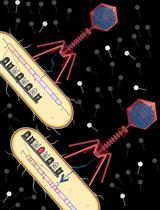
A Novel Method of Inducible Directed Evolution to Evolve Complex Phenotypes
Ibrahim S. Al’Abri [...] Nathan Crook
Oct 20, 2022 3028 Views
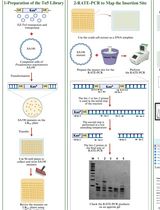
Comprehensive Mapping of EZ-Tn5 Transposon Insertion Sites in Pseudomonas argentinensis SA190 Using RATE-PCR
Büsra Elkatmis [...] Maged M. Saad
Jul 20, 2025 1697 Views
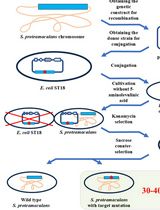
Editing the Serratia proteamaculans Genome Using the Allelic Exchange Method
Ksenia Chukhontseva [...] Ilya Demidyuk
Sep 20, 2025 1312 Views
Abstract
Generating bacterial gene deletion mutants, also known as knockouts (KOs), is a powerful tool to investigate individual gene functions. However, fastidious bacteria such as Francisella tularensis (F. tularensis) often are difficult to genetically manipulate. Indeed, many different approaches have been tested to generate F. tularensis mutants. First, Tn5-based EZ::TN transposons have been successfully used to generate transposon libraries in F. tularensis (Qin and Mann, 2006; Weiss et al., 2007). However, creating a comprehensive transposon library with saturating mutations can be laborious, screening for gene disruption requires high-throughput assays where known phenotypes can be measured, and transposons may not completely inactivate the gene of interest or may alter downstream gene expression. Second, group II introns (also referred to as Targetron) have been used to inactivate F. tularensis genes of interest (Rodriguez et al., 2008; Rodriguez et al., 2009). Targetron functions by forming a complex between plasmid-encoded RNA and chromosomal DNA, followed by group II intron insertion into the gene of interest. The main advantage of Targetron is that it does not require an antibiotic resistance marker. However, as noted for transposons, targetron gene insertions may not eliminate all gene functions or may affect downstream gene expression. Third, homologous recombination can be used to completely replace the chromosomal target gene with a selectable marker, such as an antibiotic resistance marker. This classical genetic technique has been used in many F. tularensis studies (Ramakrishnan et al., 2008; Ren et al., 2014; Mohapatra et al., 2008; Robertson et al., 2013). To accomplish this, a suicide plasmid is engineered to include a selectable marker flanked by regions upstream and downstream of the gene of interest. This KO plasmid can be delivered into host bacteria by many methods, including electroporation, chemical transformation, or conjugation. Here, we describe an optimized procedure to generate KO plasmid constructs, use E. coli to conjugatively transfer the plasmid into F. tularensis, select for F. tularensis KOs using a series of kanamycin-, hygromycin-, and sucrose-resistance steps, and confirm that the gene of interest has been deleted (general overview of the knockout protocol diagramed in Figure 1). This optimized procedure is relatively simple, rapid, and, more importantly, includes a series of both positive and negative selection steps to increase the chances of deleting a target gene from F. tularensis.
Keywords: Francisella tularensis 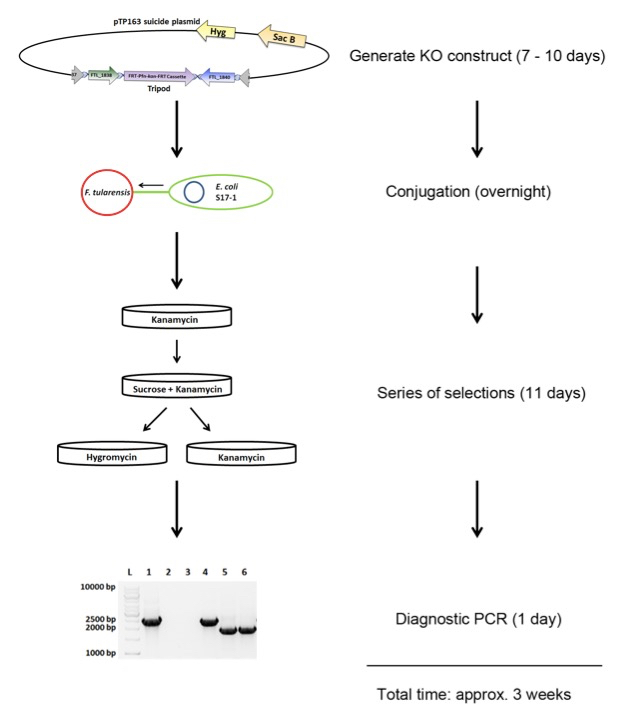
Figure 1. General overview of knockout protocol
Materials and Reagents
- Francisella tularensis, including subsp. tularensis (Type A; e.g. SchuS4) or subsp. holarctica (Type B; e.g. LVS)
Note: This protocol has been demonstrated to work in F. tularensis strains SchuS4, LVS, and OR96-0246 (Type B). All strains available from BEI Resources.
- Trizol (Life Technologies, catalog number: 15596018 )
- Platinum Taq DNA Polymerase High Fidelity (Life Technologies, catalog number: 11304-011 )
- pLG66a (Gallagher et al., 2008)
- QIAquick PCR Purification Kit (QIAGEN, catalog number: 28106 )
- QIAquick Gel Extraction Kit (QIAGEN, catalog number: 28706 )
- Agarose (Lonza, catalog number: 50004 )
- Ethidium bromide, 1% solution (Fisher BioReagents, catalog number: BP1302-10 )
- pTP163 (suicide KO plasmid; Robertson et al., 2013)
- LB broth (Fisher BioReagents, catalog number: BP1426-2 )
- Glycerol (Fisher BioReagents, catalog number: BP2291 )
- Bacto agar (Becton Dickinson, catalog number: 214010 )
- Hygromycin B solution (50 mg/ml) (Corning, catalog number: 30-240-CR )
- QIAprep Spin Miniprep Kit (QIAGEN, catalog number: 27106 )
- Apa I restriction endonuclease (New England Biolabs, catalog number: R0114L )
- Antarctic Phosphatase (New England Biolabs, catalog number: M0289S )
- T4 DNA ligase (New England Biolabs, catalog number: M0202S )
- NEB-10 beta chemically competent E. coli (New England Biolabs, catalog number: C3019I )
- Kanamycin monosulfate (MP Biomedicals, catalog number: 194531 )
- GoTaq Green Master Mix (Promega Corporation, catalog number: M7128-C )
- Molecular Biology Grade Water, DNase-, RNase-, and Protease-free (Corning, catalog number: 46-000-CM )
- E. coli strain S17-1 (Simon et al., 1983; generous gift from Drs. Michael Norgard and Greg Robertson, U.T. Southwestern Medical Center, Dallas, TX)
- Calcium chloride dehydrate (Fisher BioReagents, catalog number: BP510-100 )
- Mueller Hinton Broth powder (Becton Dickinson, catalog number: 211443 )
- Tryptone (Fisher BioReagents, catalog number: BP1421-500 )
- Sodium chloride (Fisher BioReagents, catalog number: BP358-212 )
- IsoVitaleX Enrichment (BD, catalog number: 211876 )
- Glucose (Fisher BioReagents, catalog number: BP350-1 )
- Iron(III) pyrophosphate (Sigma-Aldrich, catalog number: P6526-100G )
- Phosphate-buffered saline (PBS) 1x, without calcium and magnesium (Corning, Mediatech, catalog number: 21040CV )
- Membrane filters, 0.025 µm, 25 mm (EMD Millipore, catalog number: VSWP02500 )
- Hemoglobin powder (Neogen Acumedia, catalog number: 7195 )
- Polymyxin B sulfate (MP Biomedicals, catalog number: 100565 )
- Magnesium chloride hexahydrate (Fisher BioReagents, catalog number: BP214-500 )
- D-Sucrose (Fisher BioReagents, catalog number: BP220-212 )
- Sodium hydroxide (Fisher BioReagents, catalog number: BP359-500 )
- LB broth (see Recipes)
- LB agar (see Recipes)
- Supplemented Mueller Hinton Broth (sMHB) (see Recipes)
- Supplemented Mueller Hinton Agar (sMHA) (see Recipes)
- Chocolate agar plates containing hygromycin and polymyxin B (see Recipes)
- sMHA containing 10 mg/L kanamycin and 8% sucrose (sMHA-kan10-suc) (see Recipes)
Equipment
- Applied Biosystems Veriti 96-Well Thermal Cycler or thermal cycler with ramp rate > 3 °C/sec
- Thermo Scientific MaxQ 6000 Incubated/Refrigerated Stackable Shakers
- Thermo Scientific Forma Steri-Cycle CO2 Incubators
Procedure
- Primer design
Primer design is one of the most important steps for generating a KO. First, find your gene of interest in the associated strain genome and copy the DNA sequence containing approximately 1 kb upstream of your gene of interest, your gene of interest, and 1 kb downstream of your gene of interest. To demonstrate this procedure, FTL_1839-a Francisella tularensis subsp. holarctica LVS lipase/acyltransferase-will be targeted for primer design and KO in this protocol (Figure 2A). To generate a KO construct, two primers (named “A” and “B”) will be needed to amplify the upstream flanking region and two primers (named “C” and “D”) will be needed to amplify the downstream flanking region. Note that primers B and C must be located immediately upstream and downstream, respectively, from your gene of interest as any sequences between primers B and C will be deleted (Figure 2A). However, the locations of primers A and D are much more flexible. Whereas traditional bacterial KO constructs have contained 1 kb flanking regions, we have found that 500 bp flanking regions are sufficient to initiate homologous recombination and gene deletion in F. tularensis. The major advantage of 500 bp flanking regions is that they are shorter than 1 kb flanking regions and, thus, there is less chance for mutations during sequential PCR amplification steps (described below). Primer lengths and locations in upstream and downstream flanking regions are fairly flexible but we have found that the optimum melting temperature (Tm) for each primer should be between 50 °C and 60 °C. For the demonstration FTL_1839 KO construct, the Tm for each primer is between 55 and 56 °C (Figure 2B-C). Melting temperature calculations only should be based on primer regions homologous to the genomic sequence and should exclude engineered restriction sites and other primer modifications. When the four primer regions have been selected, Primers A and D should be modified by adding Apa I restriction sites (GGGCCC; indicated by orange nucleotides in Figure 2C) immediately 5’ of the genomic sequence and a six random nucleotide extension should be added to the 5’ end of each primer to facilitate restriction digest efficiency (indicated by grey nucleotides in Figure 2C). The 5’ ends of Primers B and C should be modified to include sequences from the 5’ and 3’ ends of the FLP recombination target (FRT)-flanked Pfn-kanamycin resistance cassette (FRT-Pfn-kan-FRT) from pLG66a (Gallagher et al., 2008; indicated by purple nucleotides in Figure 2C). Two additional primers, Kan5’ and Kan3’ (Figure 2D), are needed to amplify the FRT-Pfn-kan-FRT cassette from pLG66a (see step 2). Given the relatively short length of the above noted primers and small amount of each primer needed for PCR amplification, we typically order 25 nM scale oligonucleotides with standard desalting. Although difficult to predict, it may be necessary to retain the 5’ or 3’ ends of your gene of interest to avoid polar effects on upstream or downstream genes. A promoter prediction tool, such as PePPER (http://pepper.molgenrug.nl/index.php/prokaryote-promoters), should be used to analyze your gene of interest for cryptic promoters. If a putative promoter is found in your gene of interest, the location of Primers B and/or C may need to be shifted so that the putative promoter is retained following gene deletion.
- First-round PCR: Amplification of upstream and downstream flanking regions and the kanamycin resistance cassette
- Primers A, B, C, D, Kan5’, and Kan3’ should be suspended in dH2O to a stock concentration of 40 µM.
- F. tularensis genomic DNA should be prepared using Trizol reagent, following the manufacturer’s instructions, and suspended in dH2O. We have tested other genomic DNA extraction techniques and kits but, in our experience, Trizol reagent yields the highest quality DNA (260 nm / 280 nm ratio between 1.8 and 2.0).
- PCR amplifications should be performed using a high-fidelity Taq polymerase, such as Platinum Taq DNA Polymerase High Fidelity (Life Technologies).PCR reactions typically contain 0.2 µM of each primer and 100 to 250 ng of F. tularensis DNA.
- In the first round of PCR amplifications, three reactions are performed:
- Primers A and B are used to amplify the upstream flanking region from F. tularensis DNA (Figure 3A);
- Primers C and D are used to amplify the downstream flanking region from F. tularensis DNA (Figure 3A);
- Primers Kan5’ and Kan3’ are used to amplify the FRT-Pfn-kan-FRT cassette from pLG66a (plasmid purified using the QIAprep Spin Miniprep Kit and eluted using provided EB buffer; Gallagher et al., 2008; Figure 3A).
PCR amplification should be performed following the manufacturer’s instructions.

Figure 2. Primer design for generating a FTL_1839 KO construct. A. The genomic organization of flanking genes and FTL_1839 (gene to be deleted) are represented by large arrows. The direction of each large arrow indicates the open reading frame orientation. Small black arrows with associated letters A, B, C, and D indicate approximate locations of Primers A, B, C, and D needed to generate the upstream and downstream flanking regions. B. F. tularensis subsp. holarctica LVS genomic sequence flanking the FTL_1839 gene. The upstream gene, FTL_1838, is indicated by green nucleotide letters. The gene to be deleted, FTL_1839, is indicated by red nucleotide letters. The downstream gene, FTL_1840, is indicated by blue nucleotide letters. Regions selected for Primers A, B, C, and D are indicated by bolded and underlined nucleotides. C. Following primer location selection, Primers A and D should be modified to aid in cloning and primers B and C should be modified for inclusion of a kanamycin resistance gene between the upstream and downstream regions. For all primers, the F. tularensis subsp. holarctica LVS genomic sequence is indicated by bolded and underlined nucleotides. For Primers A and D, random nucleotide extensions on the 5’ ends of each primer are indicated by grey nucleotide letters and Apa I restriction sites (GGGCCC) are indicated by orange nucleotide letters. For Primers B and C, the 5’ and 3’ ends, respectively, of the kanamycin resistance gene (nucleotides in purple) have been added to the 5’ ends of each primer for subsequent inclusion of the kanamycin resistance gene between the two flanking regions (described in step 4). D. Primers Kan5’ and Kan3’ for amplification of the kanamycin cassette, FRT-Pfn-kan-FRT, from pLG66a.
- Primers A and B are used to amplify the upstream flanking region from F. tularensis DNA (Figure 3A);
- Correct length products should be purified using the QIAquick PCR Purification Kit. For PCR amplifications that result in multiple bands, the correct length product should be excised from the agarose gel and purified using the QIAquick Gel Extraction Kit. Alternatively, PCR amplification conditions can be optimized by adjusting the annealing temperature 1 to 5 °C to improve PCR product quality and quantity.
- Correct length products should be purified using the QIAquick PCR Purification Kit. For PCR amplifications that result in multiple bands, the correct length product should be excised from the agarose gel and purified using the QIAquick Gel Extraction Kit. Alternatively, PCR amplification conditions can be optimized by adjusting the annealing temperature 1 to 5 °C to improve PCR product quality and quantity.
- Primers A, B, C, D, Kan5’, and Kan3’ should be suspended in dH2O to a stock concentration of 40 µM.
- Second-round PCR: Splicing-Overlap Extension (SOE) PCR
SOE PCR (Horton et al., 2013) is used to fuse the A-B upstream flanking region, the FRT-Pfn-kan-FRT cassette, and the C-D downstream flanking region into one large amplicon, termed a “tripod” (Figure 3B).
- As noted above, this PCR amplification should be performed using a high-fidelity Taq polymerase, such as Platinum Taq DNA Polymerase High Fidelity. In addition, rapid temperature ramping (> 3 °C/sec) is necessary for SOE PCR due to length of the tripod (approx. 2.5 kb) and difficulty annealing three DNA fragments into one tripod template.
- For the SOE PCR reaction, we typically add 25 ng/500 bp of each first-round PCR product to the reaction and 0.2 µM of Primer A and D. Based on previous results, SOE PCR reactions require 30 to 40% more Taq polymerase to yield sufficient PCR product for subsequent cloning.
- Recommended SOE PCR amplification conditions:
1. 94 °C 2 min
--------------------------------
2. 94 °C 30 sec
3. 40 – 42 °C 45 sec
4. 68 °C 3 min 30 sec
Repeat steps 2 to 4 6×
--------------------------------
5. 94 °C 30 sec
6. 42 – 48 °C 45 sec
7. 68 °C 3 min 30 sec
Repeat steps 5 to 7 24×
--------------------------------
8. 68 °C 10 min
9. 4 °C hold
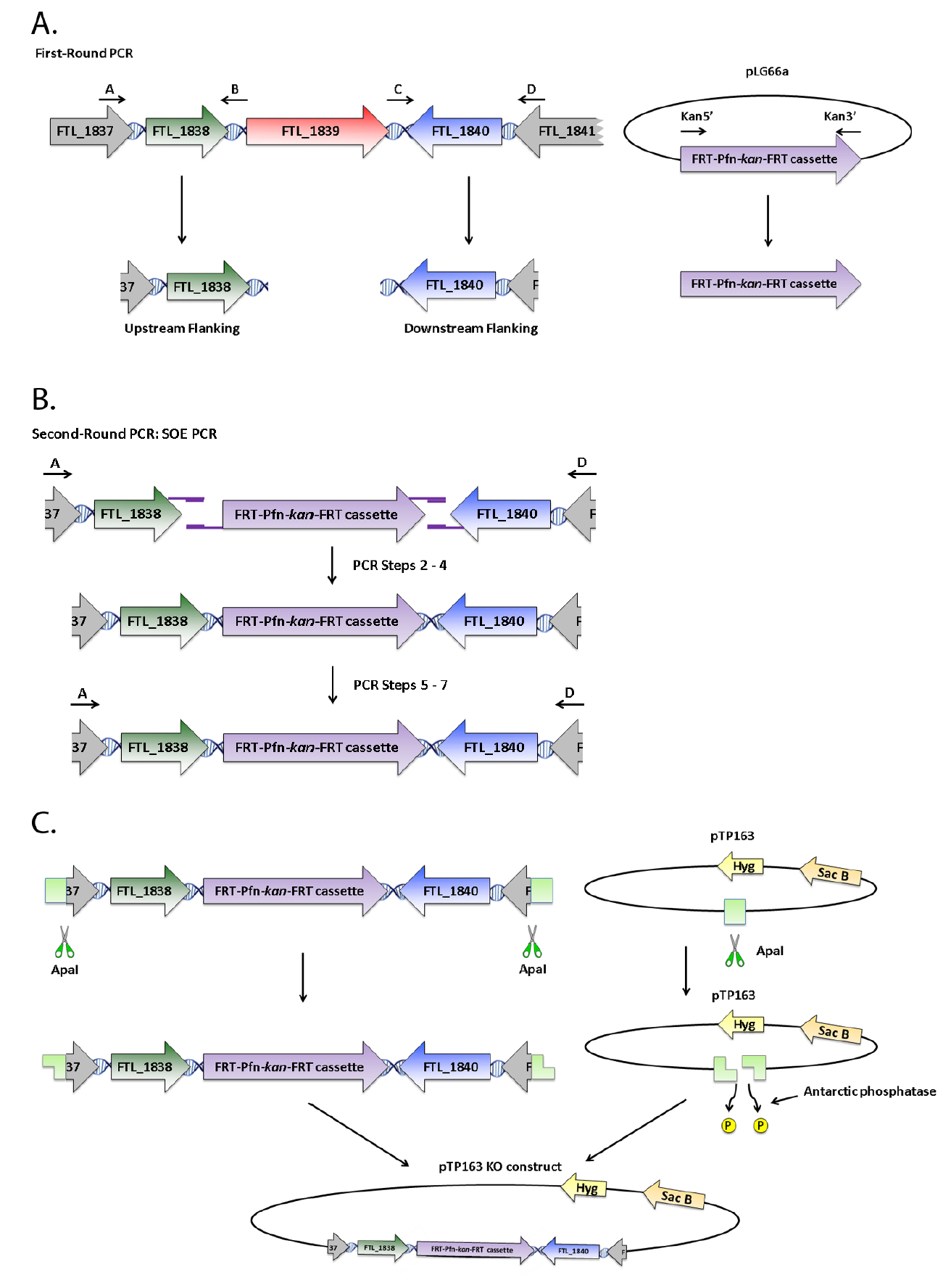
Figure 3. Tripod PCR amplication and cloning into pTP163. A. First-round PCR amplification of A-B upstream and C-D downstream flanking regions from F. tularensis genomic DNA and the FRT-Pfn-kan-FRT cassette from pLG66a. B. Second-round SOE PCR amplification to fuse the A-B upstream flanking region, FRT-Pfn-kan-FRT cassette, and C-D downstream flanking region into a tripod. C. Apa I restriction digestion of the tripod and suicide plasmid pTP163, Antarctic Phosphatase treatment of pTP163, and ligation to generate the KO plasmid.
- Following SOE PCR amplification, verify tripod length and purity by separating a portion of the SOE PCR reaction on agarose gels containing ethidium bromide. For the demonstration FTL_1839 KO construct, the expected tripod length is 2,484 bp. Correct length products should be purified using the QIAquick PCR Purification Kit. SOE PCR amplifications often result in multiple bands, thus the correctly sized product should be excised from the agarose gel and purified using the QIAquick Gel Extraction Kit.
Troubleshooting notes:
- Based on the overall tripod length (approx. 2.5 kb), the extension times in PCR Step 4 theoretically could be 2 min to 2 min 30 sec. However, we have found that longer extension times (3 min 30 sec) increase the tripod yield and reduce the amount of non-specific amplicons in the final PCR product.
- We also have found that a suboptimal (2 to 6 °C lower than the Tm) annealing temperature in PCR Step 3, followed by an optimal annealing temperature in PCR Step 6 increases tripod yield and reduces the amount of non-specific amplicons in the final PCR product. We presume that less stringent assembly and replication of the tripod are necessary during the initial rounds of SOE PCR (PCR steps 2-4; Figure 3B) but that more stringent conditions are needed during the final SOE amplification steps (PCR steps 5-7; Figure 3B) for efficient and specific tripod generation. Annealing temperatures in PCR steps 3-6 need to be carefully optimized for each SOE PCR reaction.
- Based on the overall tripod length (approx. 2.5 kb), the extension times in PCR Step 4 theoretically could be 2 min to 2 min 30 sec. However, we have found that longer extension times (3 min 30 sec) increase the tripod yield and reduce the amount of non-specific amplicons in the final PCR product.
- As noted above, this PCR amplification should be performed using a high-fidelity Taq polymerase, such as Platinum Taq DNA Polymerase High Fidelity. In addition, rapid temperature ramping (> 3 °C/sec) is necessary for SOE PCR due to length of the tripod (approx. 2.5 kb) and difficulty annealing three DNA fragments into one tripod template.
- Purify the suicide plasmid, pTP163
- While completing steps 1 through 3 above, the suicide plasmid pTP163 (contains a hygromycin resistance gene and the sacB sucrose sensitivity gene (Robertson et al., 2013)) should be purified for cloning. pTP163 can be transformed and replicated in any standard E. coli cloning strain, such as DH5α. Bacterial stocks should be made in LB broth containing 15% glycerol and stored at -80 °C until use.
- Plate a small scraping from the freezer stock onto LB agar plates containing 200 mg/L hygromycin (LB-hyg plates), incubate overnight at 37 °C, pick a single colony, inoculate into 5 ml LB broth containing 200 mg/L hygromycin, incubate overnight (O/N) with shaking, and purify pTP163 using the QIAprep Spin Miniprep Kit.
- While completing steps 1 through 3 above, the suicide plasmid pTP163 (contains a hygromycin resistance gene and the sacB sucrose sensitivity gene (Robertson et al., 2013)) should be purified for cloning. pTP163 can be transformed and replicated in any standard E. coli cloning strain, such as DH5α. Bacterial stocks should be made in LB broth containing 15% glycerol and stored at -80 °C until use.
- Apa I restriction digest of the tripod and pTP163
In this step, both the tripod (from step 3) and pTP163 (from step 4) are digested with Apa I for cloning (Figure 3C). To obtain enough product after restriction digestion, 2 µg of tripod and 2 µg of pTP163 should be added to each reaction. Restriction digest conditions are as follows:
2 µg DNA (pTP163 or tripod)
5 µl 10x CutSmart Buffer
0.5 µl Apa I (New England Biolabs, 50,000 units/ml, 25 units)
Add molecular grade water to 50 µl total
Incubate at 25 °C for 30 min
Following the 30 min incubation at 25 °C, only the tripod digestion should be purified using the QIAquick PCR Purification Kit. Immediately proceed to step 6 with the Apa I-digested pTP163.
- Antarctic Phosphatase treatment of pTP163
- Immediately following 30 min of incubation at 25 °C, the Apa I digest of pTP163 should be heat-inactivated at 65 °C for 20 min. We have found that, following Apa I restriction digestion, heat inactivation of Apa I is needed to reduce pTP163 degradation.
- Following heat-inactivation, pTP163 should be treated with Antarctic Phosphatase to avoid self-ligation (Figure 3C). Add the following Antarctic Phosphatase components to the heat-inactivated pTP163 tube as follows:
1 µl Antarctic phosphatase (5,000 units/ml, 5 units)
5.5 µl 10x Antarctic phosphatase reaction buffer
Incubate at 37 °C for 1 h
- Following Antarctic phosphatase treatment, purify pTP163 using the QIAquick PCR Purification Kit.
- Immediately following 30 min of incubation at 25 °C, the Apa I digest of pTP163 should be heat-inactivated at 65 °C for 20 min. We have found that, following Apa I restriction digestion, heat inactivation of Apa I is needed to reduce pTP163 degradation.
- Ligate tripod and pTP163
To ensure successful ligation of the tripod and pTP163 (Figure 3C), we typically perform three separate ligations at the same time, with different ratios of tripod to pTP163 (e.g., 3:1, 2:1, and 1:1). Ligation conditions are as follows:
9 µl tripod (from step 5) and pTP163 (from step 6) mixture
1 µl 10x T4 DNA ligase reaction buffer
0.4 µl T4 DNA ligase (400,000 units/ml, 160 units)
Incubate at 22 °C for 1 h
- Transform KO construct into standard E. coli cloning strain
Each ligation product should be transformed into an aliquot of a standard cloning strain of E. coli. We typically use NEB 10-beta competent E. coli. Transformation procedures are as follows:
- Add 10 µl of each ligation product to 20 µl of competent E. coli.
- Gently mix the cells and incubate on ice for 30 min.
- Heat shock at 42 °C for 30 sec.
- Place cells back on ice and immediately add 1 ml SOC medium (included in NEB 10-beta competent E. coli package).
- Incubate the transformed cells at 37 °C with vigorous shaking for 1 h to recover.
- Plate 500 µl of transformation onto a LB agar plate containing 30 mg/L kanamycin (LB-kan30 plate) and incubate O/N at 37 °C.
- Add 10 µl of each ligation product to 20 µl of competent E. coli.
- KO plasmid purification for diagnostic PCR and restriction digest
- After overnight incubation, select up to five single colonies (depending on the number of colonies that grew on the plate) for plasmid purification and diagnostic screening.
- Inoculate each colony into 5 ml of LB broth containing 30 mg/L kanamycin, incubate O/N with shaking at 37 °C and purify plasmids using the QIAprep Spin Miniprep Kit.
- We typically use GoTaq Green for diagnostic PCR. To confirm that kanamycin-resistant colonies contain A-B upstream flanking regions or C-D downstream flanking regions, diagnostic PCR is performed as follows (in this example, only the A-B upstream flanking region is amplified):
1 µl of 4 µM Primer A (0.2 µM final)
1 µl of 4 µM Primer B (0.2 µM final)
0.5 µl purified plasmid (100-150 ng)
10 µl 2x GoTaq Green Master Mix
Add molecular grade water to 20 µl total
PCR amplification should be performed following the manufacturer’s instructions.
- To further validate that the kanamycin-resistant colony contains a full-length tripod, we typically perform diagnostic digestions of purified plasmids. Diagnostic restriction digest conditions are as follows:
500 ng purified plasmid
2 µl 10x CutSmart Buffer
0.5 µl Apa I
Add molecular grade water to 20 µl total
Incubate at 25 °C for 30 min to 1 h
- Diagnostic PCR and restriction digests should be verified by separating products on agarose gels containing ethidium bromide.
- After overnight incubation, select up to five single colonies (depending on the number of colonies that grew on the plate) for plasmid purification and diagnostic screening.
- DNA sequencing to verify KO construct integrity
Plasmids from Step 9 that are positive by diagnostic PCR and restriction digest should be sent for DNA sequencing to confirm integrity of the upstream and downstream sequences. This is critical to ensure that no mutations have been introduced into either upstream or downstream flanking regions. Given the relatively short length of A-B and C-D flanking regions, we typically perform DNA sequencing with pTP163-5’ and pTP163-3’ primers (Figure 4). Primer pTP163-5’ binds 117 bp upstream of the Apa I restriction site and primer pTP163-3’ binds 64 bp downstream of the Apa I restriction site.

Figure 4. Sequencing primers used to verify KO construct integrity. Primers pTP163-5’ and pTP163-3’ are used to confirm the sequence integrity of the KO constructs.
- Transform KO construct into E. coli strain S17-1
E. coli strain S17-1 is a donor strain for conjugative DNA transfer to Francisella strains. We prepare chemically-competent E. coli S17-1 as follows:
- Plate a small scraping from the S17-1 freezer stock onto a plain LB agar plate (no antibiotics) and incubate O/N at 37 °C.
- Pick a single colony, inoculate into 5 ml plain LB broth (no antibiotics) and incubate O/N with shaking at 37 °C.
- Pellet the bacteria at 2,500 x g for 10 min at 4 °C.
- Suspend the bacterial pellet in 8 ml of ice-cold 0.1 M CaCl2 and incubate on ice for 30 min.
- Pellet the bacteria at 2,500 x g for 10 min at 4 °C.
- Suspend the bacterial pellet in 800 µl of an ice-cold solution containing 0.1 M CaCl2 and 10% glycerol.
- Prepare 50 µl aliquots and store at -80 °C until use.
To transform chemically-competent E. coli S17-1, mix 20 µl of chemically-competent S17-1 bacteria with 1 µl of purified KO plasmid (approx. 250 ng; from step 9) and follow the same transformation protocol as outlined in step 8. Following the 1 h recovery, plate 100 µl of transformed E. coli S17-1 bacteria onto a LB-kan30 plate and incubate O/N at 37 °C. The next day, pick a single colony, inoculate into 5 ml of LB broth containing 30 mg/L kanamycin, and incubate O/N with shaking at 37 °C. The following day, a portion of the O/N growth should be stored at -80 °C in 15% glycerol while 500 µl of the O/N growth should be saved for conjugation (step 12).
- Plate a small scraping from the S17-1 freezer stock onto a plain LB agar plate (no antibiotics) and incubate O/N at 37 °C.
- Conjugation
- F. tularensis preparation. At least 18 to 20 h before conjugation, plate F. tularensis onto a supplemented Mueller Hinton agar (sMHA) plate (Huntley et al., 2007) and incubate at 37 °C with 5% CO2. The day of conjugation, scrape all the F. tularensis growth from the sMHA plate and transfer to a 1.5 ml centrifuge tube containing 500 µl of sterile PBS. Using a P1000 (or equivalent) micropipettor, evenly suspend the bacteria in PBS.
- E. coli strain S17-1 preparation. Using freshly grown overnight cultures of E. coli S17-1 bacteria from step 11, pellet 500 µl at 1,000 x g for 10 min at 4 °C and remove the supernatant. If your E. coli S17-1 needs to be grown from freezer stocks, we have found that it is best to first streak the bacteria onto LB-kan30 plates, then pick a single colony for O/N growth in LB broth containing 30 mg/L kanamycin. In our experience, E. coli S17-1 freezer stocks inoculated directly into O/N LB broth result in poor conjugation efficiencies.
- Membrane filter placement. Using sterile forceps, place a 0.025 µM membrane filter in the center of a sMHA plate. Gently tap the membrane onto the agar surface to ensure contact.
- Mixing F. tularensis and S17-1. Transfer 50 µl of the F. tularensis suspension from step 12a into the tube containing the E. coli S17-1 pellet from Step 12b. Using a P100 (or equivalent) micropipettor, gently pipet up and down 5 to 10 times to suspend the E. coli S17-1 bacteria and prepare a homogenous suspension with F. tularensis. Based on previous experience and bacterial enumeration studies, the ideal ratio of F. tularensis to E. coli S17-1 is approximately 10:1.
- Conjugation incubation. Transfer the bacterial mixture from step 12d onto the center of the membrane filter from step 12c. Incubate the sMHA plate, membrane side up, at 30 °C with 5% CO2 for 16 to 24 h. The lower incubation temperature is necessary so that E. coli S17-1 will not overgrow F. tularensis during the incubation.
- F. tularensis preparation. At least 18 to 20 h before conjugation, plate F. tularensis onto a supplemented Mueller Hinton agar (sMHA) plate (Huntley et al., 2007) and incubate at 37 °C with 5% CO2. The day of conjugation, scrape all the F. tularensis growth from the sMHA plate and transfer to a 1.5 ml centrifuge tube containing 500 µl of sterile PBS. Using a P1000 (or equivalent) micropipettor, evenly suspend the bacteria in PBS.
- Conjugation recovery and selection for KO construct integration
- Following 16 to 24 h of incubation at 30 °C, use sterile forceps to transfer the membrane filter to a 50 ml conical tube, and wash the bacteria off the membrane filter using 800 µl of sterile PBS.
- Transfer the entire wash volume onto a chocolate agar plate containing 200 mg/L hygromycin and 100 mg/L polymyxin B and evenly spread the inoculum over the plate surface.
- Incubate the chocolate agar plate upside down at 37 °C with 5% CO2 for 3 to 4 days, or until colonies begin to appear. The purpose of this step is to select against E. coli S17-1 and select for F. tularensis colonies (F. tularensis is relatively resistant to polymyxin B) that have integrated the KO construct.
- Following 16 to 24 h of incubation at 30 °C, use sterile forceps to transfer the membrane filter to a 50 ml conical tube, and wash the bacteria off the membrane filter using 800 µl of sterile PBS.
- Kanamycin selection for colonies containing the KO construct
When colonies are visible on the chocolate agar plate, pick individual colonies and streak onto separate quadrants of sMHA plates containing 10 mg/L kanamycin (sMHA-kan10). We typically pick up to 8 colonies for kanamycin selection. Incubate at 37 °C with 5% CO2 for 24 h. The purpose of this step is to select for colonies that have incorporated the suicide plasmid pTP163, including the KO construct, into the genome (1st recombination step).
- Kanamycin and sucrose selection for colonies containing the KO construct
- After 24 h of incubation, individual colonies are rarely visible. Bacterial growth from the sMHA-kan10 plates are transferred to sMHA plates containing both 10 mg/L kanamycin and 8% sucrose (sMHA-kan10-suc).
- Better results are obtained when bacterial growth from the sMHA-kan10 plates is heavily streaked onto quadrants of sMHA-kan10-suc plates because this selection step is stringent and may kill many bacteria.
- Single colonies likely will appear in 2 to 4 days on sMHA-kan10-suc plates. The purpose of this step is to force the release the suicide plasmid from the genome (2nd recombination step), resulting in either the deletion of the kanamycin resistance cassette (undesirable result) or your gene of interest (preferred result).
- Only colonies that retain the suicide plasmid, and thus the sacB sucrose sensitivity gene, will be sucrose sensitive.
- After 24 h of incubation, individual colonies are rarely visible. Bacterial growth from the sMHA-kan10 plates are transferred to sMHA plates containing both 10 mg/L kanamycin and 8% sucrose (sMHA-kan10-suc).
- Replica plating to select for hygromycin-sensitive and kanamycin-resistant colonies
After 2 to 4 days of incubation on sMHA-kan10-suc plates, colonies that are resistant to both kanamycin and sucrose are picked using toothpicks and replica plated onto two separate plates in the following order:
- sMHA containing 200 mg/L hygromycin (sMHA-hyg; to ensure colonies are hygromycin sensitive)
- sMHA-kan10; to ensure colonies are kanamycin resistant)
Heavily streak individual colonies onto pre-labeled quadrants of each plate and incubate at 37 °C with 5% CO2 for 2 to 3 days. Sterile toothpicks are used in this step because the colonies are too small to be picked with inoculation loops. Only colonies that are kanamycin-resistant and hygromycin-sensitive should be considered as potential KOs. These colonies should be re-streaked onto fresh sMHA-kan10 plates, incubated for 1 day, suspended in sMHB, and stored at -80 °C until use.
Troubleshooting note: Sucrose-resistant colonies (from step 15) that remain hygromycin-resistant (from step 16) do commonly occur and are the result of a suppressor mutation which confers sucrose resistance. Hygromycin-resistant colonies should not be further screened as they still contain the unresolved suicide plasmid. If all colonies are hygromycin-resistant following step 16, more single colonies should be selected from the sMHA-kan10-suc plates in step 15 and replica plated onto sMHA-hyg and sMHA-kan10, as described in step 16. If kanamycin-resistant and hygromycin-sensitive colonies still cannot be obtained following Step 16, we suggest starting over with conjugation (step 12). In our experience, conjugation can be repeated up to three times to increase the chances of selecting a KO. However, if kanamycin-resistant and hygromycin-sensitive colonies cannot be obtained after three conjugations, this likely indicates that your gene is essential.
- sMHA containing 200 mg/L hygromycin (sMHA-hyg; to ensure colonies are hygromycin sensitive)
- Diagnostic PCR to confirm KOs
- Diagnostic PCR should be performed to confirm that kanamycin-resistant and hygromycin-sensitive colonies from Step 16 are genuine KOs.
- Genomic DNA should be prepared by placing a kanamycin-resistant colony in 50 µl of 50 mM NaOH, boiling the solution for 10 min, briefly centrifuging to pellet insoluble material, and transferring the supernatant to a new microfuge tube.
- We typically perform 3 separate PCR reactions to verify that the kanamycin-resistant colonies are actual KOs (Figure 5).
- Diagnostic PCR reactions are performed as described in step 9, typically contain 0.5 µl of genomic DNA, and include the following primer pairs:
Primers A and D
Primers A and Kan3’
Primers Kan5’ and D
If your gene of interest has been deleted from the potential KO colony, all three primer pairs should amplify specific-sized targets from genomic DNA. However, if primer pair A and D are the only primers to amplify targets from the potential KO colony, then this colony is unlikely to be a KO. In our experience, it is unlikely that potential KO colonies (kanamycin-resistant, sucrose-resistant, hygromycin-sensitive) will be negative by all three primer pairs. However, PCR conditions do need to be carefully optimized to obtain amplicons with all three primer pairs.
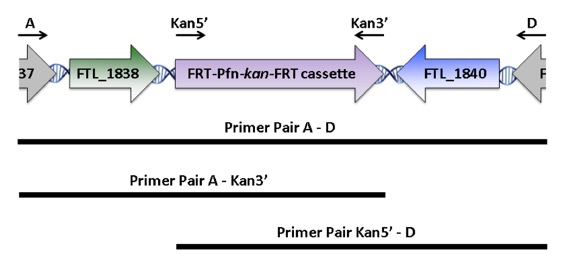
Figure 5. Diagnostic PCR to confirm KO candidates. Three pairs of PCR primers are used to confirm that your gene of interest has been replaced by a kanamycin resistance cassette: primer pairs A-D, A - Kan3’, and Kan5’ - D.
- Diagnostic PCR should be performed to confirm that kanamycin-resistant and hygromycin-sensitive colonies from Step 16 are genuine KOs.
Representative data
- SOE PCR
SOE PCR reactions typically result in non-specific products that are not the correct size (Figure 6A). However, optimized SOE PCR reactions can amplify correct length tripods with no non-specific bands (Figure 6B). If SOE PCR cannot be optimized through changes in annealing temperature, gel purification may be performed as described in step 3.
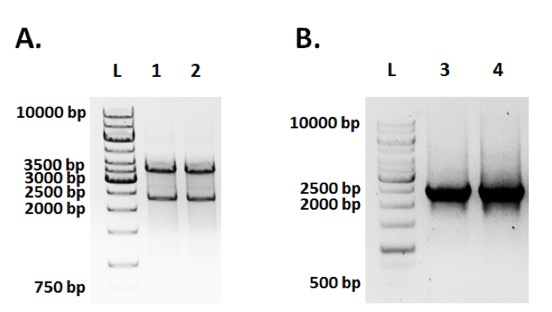
Figure 6. SOE PCR representative data. A. Lanes 1 and 2 are examples of typical SOE PCR reactions that resulted in both specific (3,400 bp) and non-specific (2,400 bp) tripod bands; B. Lanes 3 and 4 are examples of optimized SOE PCR reactions where correct length tripods (2,400 bp) were generated and non-specific bands are absent. L indicates DNA ladder with sizes noted to the left of each gel.
- Diagnostic PCR to confirm KO
Diagnostic PCR is performed in step 17 to confirm a KO candidate from step 16 (Figure 7). In this example, only primer pair A - D amplified a product from wild type genomic DNA. However, all three PCR primer pairs amplified products from the KO candidate. In this example, the A-D primer pair product from both wt and KO genomic DNA are approximately the same size because the gene of interest and the kanamycin resistant cassette are approximately the same size. Therefore, not all diagnostic PCR results will resemble this example.
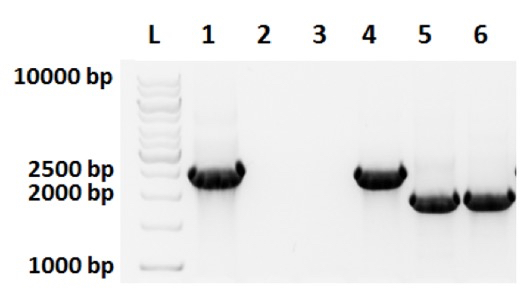
Figure 7. Diagnostic PCR to confirm KO. Lanes 1-3 are PCR products amplified from WT genomic DNA. Lane 1, primer pair A-D. Lane 2, primer pair A-Kan3’. Lane 3, primer pair Kan5’- D. Lanes 4 - 6 are PCR products amplified from KO candidate genomic DNA. Lane 4, primer pair A-D. Lane 5, primer pair A - Kan3’. Lane 6, primer pair Kan5’ -D. L indicates DNA ladder with sizes noted to the left of the gel.
Recipes
- LB broth (1 L)
25 g of LB broth powder
Dissolve in 1 L deionized water
Autoclave for 45 min
- LB agar (1 L)
25 g LB broth powder
Dissolve in 1 L deionized water
Add 16 g Bacto agar
Autoclave for 45 min
Pour LB agar into 100 mm x 15 mm Petri dishes, approx. 20 ml per plate.
LB-kan30 plates (containing 30 mg/L kanamycin) are made by adding the indicated amount of kanamycin to the recipe above immediately before pouring plates. We prepare stock solutions of kanamycin at 100 mg/ml (stored at -20 °C) for this purpose.
LB-hyg plates (containing 200 mg/L hygromycin) are made by adding the indicated amount of hygromycin to the recipe above immediately before pouring plates. Stock solutions of 50 mg/ml hygromycin are commercially available.
- Supplemented Mueller Hinton Broth (sMHB) (1 L)
21 g Mueller Hinton Broth powder
210 mg MgCl2
182 mg CaCl2
Dissolve in 1 L deionized water
Autoclave for 45 min (keep a stir bar in the bottle containing the medium)
Can be stored at room temperature for up to a month. Immediately before use, add:
20 ml IsoVitaleX Enrichment
10 ml 10% Glucose
10 ml 2.5% iron pyrophosphate
- Supplemented Mueller Hinton Agar (sMHA) (1 L)
21 g of Mueller Hinton Broth powder
10 g Tryptone
5 g Sodium chloride
Dissolve in 1 L deionized water
Add 16 g Bacto agar
Autoclave for 45 min (keep a stir bar in the bottle containing the medium)
Cool to 50 °C and add the following components immediately before pouring plates:
25 ml donor calf serum
20 ml IsoVitaleX Enrichment
10 ml 10% glucose
10 ml 2.5% iron pyrophosphate
Pour sMHA into 100 mm x 15 mm Petri dishes, approximately 20 ml per plate.
sMHA-kan10 plates (containing 10 mg/L kanamycin) are made by adding the indicated amount of kanamycin to the recipe above immediately before pouring plates. We prepare stock solutions of kanamycin at 100 mg/ml (stored at -20 °C) for this purpose.
sMHA-hyg plates (containing 200 mg/L hygromycin) are made by adding the indicated amount of hygromycin to the recipe above immediately before pouring plates. Stock solutions of 50 mg/ml hygromycin are commercially available.
- Chocolate agar plates containing hygromycin and polymyxin B
In one container, prepare:
21 g of Mueller Hinton Broth powder
10 g Tryptone
5 g sodium chloride
Dissolve in 750 ml deionized water
Add 16 g Bacto agar
Autoclave for 45 min (keep a stir bar in the bottle containing the medium)
In a second container, prepare 4% hemoglobin solution by:
Dissolve 12 g hemoglobin in 300 ml deionized water
Autoclave for 45 min
Immediately after autoclaving, add 250 ml of 4% hemoglobin solution into autoclaved Mueller Hinton solution, followed by approx. 1 min stirring, to make 1 L chocolate agar mixture.
Cool to 50 °C and add the following components immediately before pouring plates:
10 ml IsoVitaleX Enrichment
200 mg/L hygromycin
100 mg/L polymixin B
Pour chocolate agar into 100 mm x 15 mm Petri dishes, approximately 20 ml per plate
- sMHA containing 10 mg/L kanamycin and 8% sucrose (sMHA-kan10-suc)
21 g of Mueller Hinton Broth powder
10 g tryptone
5 g sodium chloride
Dissolve in 800 ml deionized water
Add 16 g Bacto agar
Autoclave for 45 min (keep a stir bar in the bottle containing the medium)
Cool to 50 °C and add the following components immediately before pouring plates:
25 ml donor calf serum
20 ml IsoVitaleX Enrichment
10 ml 10% glucose
10 ml 2.5% iron(III) pyrophosphate
10 mg/L kanamycin
200 ml 40% sucrose
Pour sMHA-kan19-suc into 100 mm x 15 mm Petri dishes, approximately 20 ml per plate.
Acknowledgments
We thank Drs. Michael Norgard and Gregory Robertson at the University of Texas Southwestern Medical Center for kindly providing original protocols and reagents to generate F. tularensis gene deletions. We thank Drs. Larry Gallagher and Colin Manoil at the University of Washington for kindly providing pLG66a. This work was supported by the National Institute of Allergy and Infectious Disease of the National Institutes of Health grants K22AI083372 and R01AI093351 to J.F.H. The content is solely the responsibility of the authors and does not necessarily represent the official views of the National Institutes of Health.
References
- Gallagher, L. A., McKevitt, M., Ramage, E. R. and Manoil, C. (2008). Genetic dissection of the Francisella novicida restriction barrier. J Bacteriol 190(23): 7830-7837.
- Horton, R. M., Cai, Z., Ho, S. M. and Pease, L. R. (2013). Gene splicing by overlap extension: tailor-made genes using the polymerase chain reaction. BioTechniques 8(5): 528-535 (November 1990). Biotechniques 54(3): 129-133.
- Huntley, J. F., Conley, P. G., Hagman, K. E. and Norgard, M. V. (2007). Characterization of Francisella tularensis outer membrane proteins. J Bacteriol 189(2): 561-574.
- Mohapatra, N. P., Soni, S., Reilly, T. J., Liu, J., Klose, K. E. and Gunn, J. S. (2008). Combined deletion of four Francisella novicida acid phosphatases attenuates virulence and macrophage vacuolar escape. Infect Immun 76(8): 3690-3699.
- Qin, A. and Mann, B. J. (2006). Identification of transposon insertion mutants of Francisella tularensis tularensis strain Schu S4 deficient in intracellular replication in the hepatic cell line HepG2. BMC Microbiol 6: 69.
- Ramakrishnan, G., Meeker, A. and Dragulev, B. (2008). fslE is necessary for siderophore-mediated iron acquisition in Francisella tularensis Schu S4. J Bacteriol 190(15): 5353-5361.
- Ren, G., Champion, M. M. and Huntley, J. F. (2014). Identification of disulfide bond isomerase substrates reveals bacterial virulence factors. Mol Microbiol 94(4): 926-944.
- Robertson, G. T., Child, R., Ingle, C., Celli, J. and Norgard, M. V. (2013). IglE is an outer membrane-associated lipoprotein essential for intracellular survival and murine virulence of type A Francisella tularensis. Infect Immun 81(11): 4026-4040.
- Rodriguez, S. A., Davis, G. and Klose, K. E. (2009). Targeted gene disruption in Francisella tularensis by group II introns. Methods 49(3): 270-274.
- Rodriguez, S. A., Yu, J. J., Davis, G., Arulanandam, B. P. and Klose, K. E. (2008). Targeted inactivation of Francisella tularensis genes by group II introns. Appl Environ Microbiol 74(9): 2619-2626.
- Simon, R., Priefer, U. and Puhler, A. (1983). A broad host range mobilization system for in vivo genetic-engineering: transposon mutagenesis in gram-negative bacteria. Bio-Technology, 1(9): p. 784-791.
- Weiss, D. S., Brotcke, A., Henry, T., Margolis, J. J., Chan, K. and Monack, D. M. (2007). In vivo negative selection screen identifies genes required for Francisella virulence. Proc Natl Acad Sci U S A 104(14): 6037-6042.
Article Information
Copyright
© 2015 The Authors; exclusive licensee Bio-protocol LLC.
How to cite
Wu, X., Ren, G. and Huntley, J. F. (2015). Generating Isogenic Deletions (Knockouts) in Francisella tularensis, a Highly-infectious and Fastidious Gram-negative Bacterium. Bio-protocol 5(12): e1500. DOI: 10.21769/BioProtoc.1500.
Category
Microbiology > Microbial genetics > Mutagenesis
Molecular Biology > DNA > Mutagenesis
Do you have any questions about this protocol?
Post your question to gather feedback from the community. We will also invite the authors of this article to respond.
Share
Bluesky
X
Copy link



